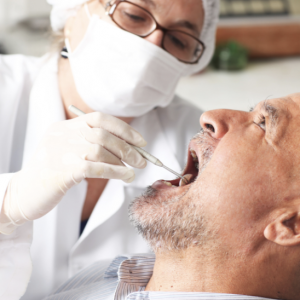Word Of Mouth: Updated Insights About Dental Care During The Pandemic

Word Of Mouth: Updated Insights About Dental Care During The Pandemic
September 23, 2020
So, have you headed back to your dentist yet? Has pain or vanity propelled you to return to your dental provider despite possible COVID risks? Although the World Health Organization recommends that routine dental visits continue to be postponed (except in cases of emergency) until transmission rates drop, many of us have nonetheless headed back and opened wide- and the condition of our teeth and mouths seem to suggest that even if we’ve been lucky enough to avoid COVID, the pandemic has taken its toll in other ways.
As we earlier profiled in agebuzz, deciding to resume routine medical and dental care requires you to ask good questions and minimize virus exposure as best as possible. On the flip side, staying home also increases the risk that festering problems may grow worse and require even more invasive care once you eventually return to your provider. Apparently no cases of virus transmission have been identified to date from exposure at a dental office. And in the best dental practices, innovative additions such as HEPA filters and UV radiation have been installed to minimize the risk of aerosolized virus hanging in the air, in addition to universal mask and face shield wearing, temperature checks, and limits on waiting room occupants.
Once back in the chair, be prepared for some distressing findings. The stress of the pandemic and disrupted routines, not to mention poor posture and sleep all seem to have led to an increased incidence of cracked teeth, destructive teeth grinding and jaw pain, at levels previously unseen in many dental practices. Dentists report an uptick in broken teeth, inflamed gums, and even dirtier teeth– probably to be expected given many of us have foregone our routine dental cleanings as well as good hygiene habits over the last many months. And if you think that’s just a matter of dental health, think again: there’s a definite link between gum health and diabetes, as well as implications for heart health.
However, if the virus doesn’t worry you then the costs of seeking out dental care just may. Given that few of us have dental insurance and lapsed dental care may lead to larger dental expenses, it’s no wonder that returning to the dentist may be as much a financial calculation as a risk-assessment exercise. One piece of good news on the horizon: Kaiser Health News recently reported the rise in the use of silver diamine fluoride as a way to help fill cavities and cut down dental costs for older adults, especially those without dental insurance. In case you’re not familiar, silver diamine fluoride is a pain-free liquid that can be quickly and inexpensively painted on teeth to stop tooth decay, even under already existing dental work. While there are pros and cons to its use (including the permanent blackening of teeth that have been painted with it), given that 27% of Americans over 65 have untreated cavities, this may be a valuable new tool for both those without resources and those who have difficulty sitting for long dental procedures- something many of us may be in for once we return to the dentist.







